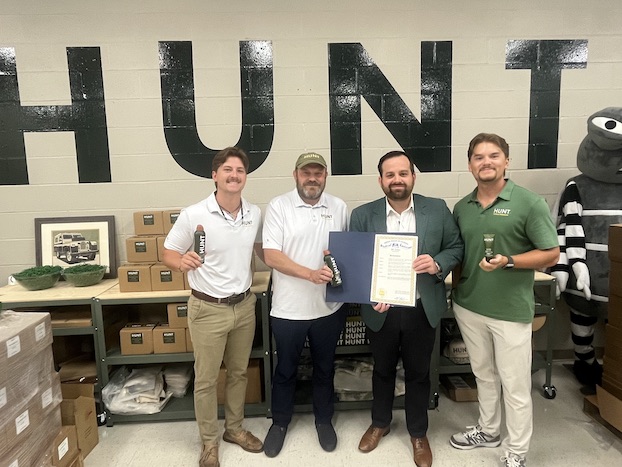Unveiling the beauty of historic renovations
Published 11:50 am Monday, March 31, 2025







Edward “Buzzy” Ribbeck sees beauty and possibility where others may only see dilapidation and devastation. Called “Buzzy” by friends, associates and loved ones after his young sister declared during their mother’s pregnancy that she was getting “a new baby buzzy,” the contractor said he thrives on problem-solving. The bigger the challenge, the better.
“My father was in construction, and I grew up having to work for him — from 8 years old forward,” he said.
After a high school drafting teacher told him he should pursue architecture because he had a talent for drawing, he studied architecture at McNeese State University. It didn’t take long, however, before he realized he was not one to sit at a desk 40 hours a week. “I mean, there’s just no way,” he said with a chuckle.
Trending
“I wanted to actually do both design and construction and was anxious to start so in 1981 or so I decided I wanted to venture off on my own. My father — who did mostly remodel and insurance repair — would say, ‘I don’t care what you do, but find something you’re passionate about and be the best.”
Ribbeck said no job is always easy “so why not find something you love? You are still going to have difficulties and struggles — and believe me I have had my share, sometimes more than my share — but it keeps you pushing and you work through it,” he said.
After founding Ribbeck Construction in 1982, he moved quickly into the broader markets of commercial and industrial construction as well as real estate property development. His desire was to be a design-builder offering architectural, engineering and construction services in-house. But restoration and remodeling are in his blood.
“I like building new structures, but I really like to remodel because it is interesting for me to watch my clients and other people go, ‘Wow.’ There is an aptitude involved. A small percentage of people have the aptitude of spatial skills needed to envision what something is going to look like in advance, such as looking at a two-dimensional drawing and converting it into a finished project in their mind. It is really rewarding to see clients say, ‘Wow,’ because with an existing structure renovation, they knew what it looked like before.”
He said remodeling has helped him substantially in designing and building new structures by learning from errors of the past.
“It’s kind of like art, but you just make a new picture,” he said. “That is why I always gravitate towards remodels. I like solving problems. Taking an existing structure and converting it into a more functional and beautiful structure to meet the needs of the client is fun. I think the more challenging the remodel, the more I am attracted to it. It is rewarding when you solve the problem.”
Trending
That passion for remodeling has led him around the country, restoring and performing historic treatments to structures in Texas, Mississippi, Alabama, Florida, Colorado and other states.
His company has performed work in over 28 states across the nation. Closer to home, to name a few, Ribbeck performed historic treatments to Cox, Cox, Filo and Camel’s office on Broad Street, First National Bank on downtown Ryan Street, Immaculate Conception Cathedral on Bilbo Street, and others in and around Southwest Louisiana — as well as the Old State Capitol, Oakley House Museum and Baton Rouge City Court.
Ribbeck said institutional and commercial organizations treasure historic buildings because the structures educate people about history, help organizations create an image in their communities and feature beautiful architecture. He said his firm’s goal is to maintain the building’s historic aesthetic flair while dealing with the real-time issues presented by the aging structure.
By blending turn-of-the-century craftsmanship with today’s technology, his firm restores the building’s historically significant elements while meeting the demands of the contemporary business environment.
For those interested in restoring historical homes and structures, Ribbeck said buyers need to be fully aware of what they are getting into.
“First, you need to make sure the seller gives you an opportunity for a thorough inspection by a highly qualified person to determine what needs to be done,” he said. “Some structures may have already been totally or partially remodeled.”
To start, one must determine if it is already on the historical registry list. “That should be step No. 1, because if it’s on the national registry they’re going to have some responsibilities to keep it on the register,” he said. “There’s specifications that you have to follow to perform work.”
If the buyer’s plan is to buy the home or structure and restore it or if their plan is to buy it and perform additional historic treatment work, the buyer may be eligible for federal and/or state tax credits — which is dollar for dollar. “If you owe a dollar in income tax and you have a dollar in tax credits it cancels out the tax debt.”
He said the state and federal government offers this incentive to encourage owners and investors to preserve historical structures, particularly those listed on the National and/or State Register of Historic Places or if located in Downtown Development or Certified Cultural Districts
“They don’t want them torn down and if you remodel the property, their desire is to have you retain the historical significance in the process. The way they do that is to dangle money,” he said with a laugh.
He said buyers are eligible to get up to 40 percent in tax credits — 20 percent in federal tax credits and 20 percent in state tax credits. Some costs are not eligible but visual aesthetics — like the roof, walls, windows, doors, exterior finishes, and interior artistry, etc. — are.
To obtain the tax credits, though, the buyer has to follow a set of guidelines set by the National Park Service and/or the State Historic Preservation Office. The four main divisions to historic treatments are preservation, rehabilitation, restoration and reconstruction. Preservation focuses on maintaining and repairing existing historic materials and features; rehabilitation involves adapting a historic building for contemporary use; restoration aims to depict property at a particular period in its history by removing features from other periods and reconstructing missing features; reconstruction involves rebuilding non-surviving portions of a structure or a building that no longer exists.
“There’s rules for each one of these of what you can and cannot do,” Ribbeck said. “From there, you can determine from the guidelines which will meet the requirements to get the tax credits. You have to deduct the values of items that do not fall into the guidelines set.”
The Louisiana Division of Historic Preservation offers a webinar series online about the historic tax credits available.
The series can be found at crt.state.la.us., www.nps.gov/orgs/1739/secretary-standards-treatment-historic-properties.htm.
“It’s a huge incentive for people to do preservation work if they follow the guidelines,” he said.
“If it is not in the national or state registry of historic places, you can apply to have it registered if it meets the standards set by the government agencies.”
Ribbeck said if the tax credits are not needed, they can be sold at a discount to other taxpayers.
Louisiana has adopted the Federal Guidelines for historic treatments, including the Secretary of Interior’s Standards for Rehabilitation and the National Historic Preservation Act as a means to follow.
He said the first step in a historic treatment process is to determine if the property is on the State or National Register of Historic Places, followed by performing the design following the guidelines and submitting the plans and documents required to the federal and/or state agency committee for review.
“There are a lot of rules to follow but it is well worth the effort,” he said. “It softens the pain and helps ensure success utilizing experienced and seasoned professionals.”












